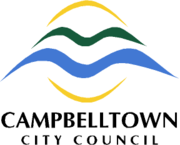City of Campbelltown (South Australia)
|
City of Campbelltown South Australia |
|||||||||||||
|---|---|---|---|---|---|---|---|---|---|---|---|---|---|
 |
|||||||||||||
| Population | 51,889 (2015 est) | ||||||||||||
| • Density | 2,131/km2 (5,520/sq mi) | ||||||||||||
| Area | 24.35 km2 (9.4 sq mi) | ||||||||||||
| Mayor | Simon Brewer | ||||||||||||
| Council seat | Rostrevor | ||||||||||||
| Region | Metropolitan Adelaide | ||||||||||||
| State electorate(s) | Morialta, Hartley | ||||||||||||
| Federal Division(s) | Mayo, Sturt | ||||||||||||
 |
|||||||||||||
| Website | City of Campbelltown | ||||||||||||
|
|||||||||||||
The City of Campbelltown is a local government area in the north eastern suburbs of Adelaide, South Australia about 6 kilometres from the Adelaide GPO. The City is bordered by the River Torrens and the City of Tea Tree Gully, the District of Adelaide Hills, the City of Burnside, the City of Norwood Payneham St Peters, and the City of Port Adelaide Enfield. The City has an estimated population of 51,889 people.
The first District Council of Payneham in South Australia was formed in 1854 when the year-old District Council of East Torrens was split, for more effective governance, into three separate local governing bodies, including the original East Torrens council and the District Council of Burnside. In 1867 the new District Council of Stepney was detached from Payneham council to better represent the more urban interests of the western wards. In the following year, on 27 February 1868, Payneham was renamed the District Council of Campbelltown. The name "Campbelltown" had been decided upon at a meeting held at the Glynde Inn on 9 December 1867 and was named after Charles James Fox Campbell. The Stepney council was later renamed in the 1930s to the District Council of Payneham, making it the second council of that name.
On 1 January 1946, the Campbelltown District Council became a town with its own municipal office and, on 6 May 1960, it was proclaimed a city.
Campbell purchased Sections 309 and 310 on a fertile plain near the River Torrens in 1842 and built a home he called "Lochend" after the ancestral home of his family in Scotland. Lochend was built of local river stone and included a stucco porch, hall and living room with a finely moulded ceiling. Campbell later substantially expanded Lochend by the addition of three bedrooms and a cellar. Lochend included 4 acres (1.6 ha) of garden and 156 acres (63 ha) in the estate, primarily used as pastoral land. In 1849 he subdivided 16 acres (6.5 ha) into 40 gardening blocks under the name "Campbelltown".
...
Wikipedia
